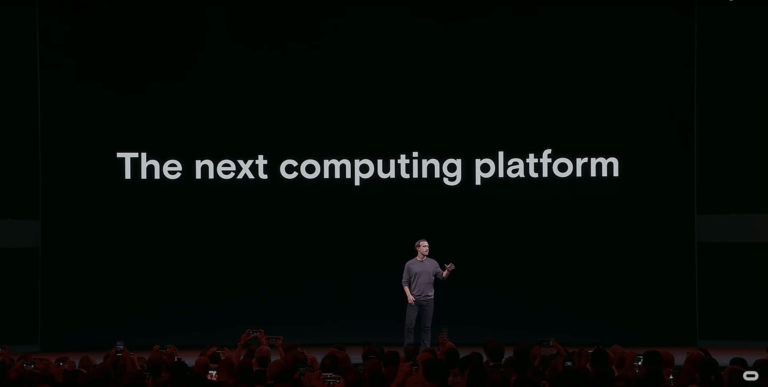
What is Facebook Spending on XR
Following Part I’s examination of Facebook’s XR road map, the author dives into estimated spending levels
Facebook says they have 10,000 employees working on XR, or about 1/6 of the company’s 58,604 employees.
I’ll do some simple math based on public information. I’ll include my notes in brackets if you want to try other variations or tell me where I’m wrong.
Using their public projections from Q1 2021, we might reasonably expect they spend about $6 billion on XR this year for salaries, hardware and overhead.
[ assuming 1/6 * 4 * (Q1’s “cost of revenue” + “R&D”) = $6B ]
Compensation alone for 10,000 mostly Silicon Valley employees could exceed $5B a year, depending on stock grants and overhead.
[ assuming $250k average salary, doubled to cover stock, benefits, overhead. ]
Hardware development costs more than software, especially when you have to outsource all of the fabrication and parts and you’re not at the top of the stack. Additional expensive acquisitions are likely. And I figure the net loss on HW sales could be over $1B already.
[ assuming $200 loss per unit, times 5 million units would be $1B ]
Why $200?
I don’t know for sure. But base units sell for $299, with $50 discounts cropping up. Stores may acquire these for $199 or less to cover their usual markup. Comparable headsets cost $600–800 without subsidies. Cell phones are in a similar price vs. technology ballpark, with different optics. I figure the likely “Cost of Goods Sold” for Quest is at least $400, implying a $200 loss per unit.
That said, the $399 version probably suffers less loss overall. And anytime Facebook can sell directly, they probably save at least $50-$100.
I’m not estimating 1st party add-ons which have higher margins and can offset some losses on the device.
So, all in all, the total outlay could be even higher than $6B a year. But that’s a decent guess IMO.
At least one person reading this will no doubt say:
But console makers always lose money on the consoles. They make it up on the games.
Sony, for example, has a mature console ecosystem, with a huge relative advantage in game prices (3x), sales channels and customer base (10x+) over Quest. Consoles run on long (7–10 year) generational cycles, giving more time to recoup early R&D costs. It’s likely that Sony and Microsoft start to actually make money on the massive quantities of identical hardware by mid-cycle. The parts are not the only expense. A big expense comes from early mistakes, defects, poor material choices. Those tend to get fixed after a year or two.
On the other hand, Quest’s upgrade model seems more like cell phones, with similar tech and short (1–3 year) upgrade cycles. Cell phone companies want you to upgrade, but ideally remain locked in to their monthly plans.
And to seal the deal, Facebook even says clearly in their reports that the vast majority of their income today comes from ads.
A very different way to come at this question is to look at earnings, on the assumption that they won’t really consider XR a success until it makes at least as much as mobile/web ads make, pro-rated.
Their 2020 overall annual revenues worked out to about $1.6M per employee. This ratio may run as high as $2M per employee some years, again due to massive ad-tech revenues.
Let’s assume these 10k employees remain in XR going forward. This implies that when they sell 10 million headsets, in order to make the same profits [conservatively assuming $16B per 10k employees], they’d need the average Quest buyer to spend another $5,000 [ = $1,600 profit at 30% ] on software.
A few may spend that much, but it seems highly unlikely to be the average.
If/when they hit 100M Quests sold, and assuming the HW loss stays at $200 per unit, I figure FB would still need buyers to spend an average of $1200 more to cover the usual profit margins. [ ( 16B / 100M + 200 ) / 0.3 = 1200 ]. But it goes down considerably with lower up-front losses. Would Facebook lower consumer prices even more, if they could? I imagine they would.
Bottom line: advertising is likely to be seen as their only hope of ever making their usual profit, while selling headsets at rock bottom prices.
I personally don’t think that’s the only way for them to make money, but it’s certainly the most likely way for a company built on “Senator, we sell ads.”
Editor’s note: A version of this post originally appeared on the author’s Medium, contributed here with permission. This concludes our two-part series on Bar-Zeev’s Facebook analysis. See Part I here.
 Avi Bar-Zeev is a design and technology leader with a background that includes Microsoft, Apple, Google Earth, Second Life, and Disney. His consulting company is RealityPrime. Follow him on Twitter at @avibarzeev and on Medium for more insightful content.
Avi Bar-Zeev is a design and technology leader with a background that includes Microsoft, Apple, Google Earth, Second Life, and Disney. His consulting company is RealityPrime. Follow him on Twitter at @avibarzeev and on Medium for more insightful content.






